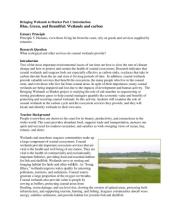
In the struggle to slow climate change, coastal wetlands are a critical asset—acre for acre, they can store up to five times as much carbon as rainforests. When wetlands are damaged or destroyed, they shift from being carbon “sinks ” to being carbon sources that release greenhouse gases into the atmosphere. Unfortunately, wetlands are disappearing at an alarming pace, and decisions to develop, protect, or restore them are often made in the context of limited public resources. Trading wetlands carbon offsets on carbon markets is an exciting new approach to creating financial incentives for restoration and conservation. To help “bring wetlands to market, ” the Waquoit Bay Reserve led a cutting-edge, collaborative research project in 2011 that examined the relationship between salt marshes, climate change, and nitrogen pollution and developed tools to leverage the “blue carbon ” stored in wetlands to achieve broader management goals.
About this resource
As part of this project, the team developed a high school STEM curriculum that examines the relationship between salt marshes, climate change, nitrogen pollution, and the economic value of salt marshes as carbon sinks. Linked to the Next Generation Science Standards, the curriculum module introduces many aspects of the research project and provides teaching ideas and activities for sharing it with teachers and students.